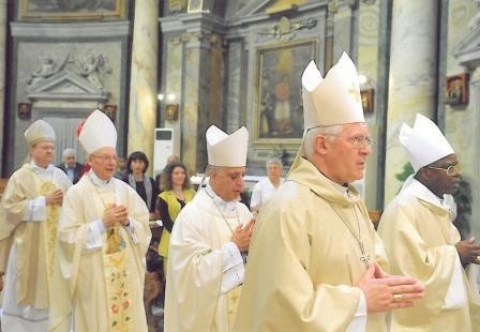Chronicle
 The Cardinals and Bishops in Procession
The Cardinals and Bishops in Procession
On 12 June 2012, the Pontifical Council for Culture celebrated thirty years of its existence.
In the morning, people who had been involved in the life of the Dicastery since its creation gathered in the church of Sant’Anna in the Vatican for a Eucharistic Celebration presided over by Cardinal Gianfranco Ravasi.
In the afternoon, the celebration continued with a Public Session held in the auditorium of our new building, Palazzo Pio X in via della Conciliazione, to reflect on the past, present and future of the Dicastery with the objectives outlined by John Paul II.
In fact, the PCC was born after a long period of gestation on 20 May 1982 as a fruit of the Second Vatican Council.
The ceremony was overseen by His Excellency the Delegate, Monsignor Carlos Azevedo and began with a brief greeting by the Secretary of the Council, His Excellency Monsignor Barthélemy Adoukonou.
Aware of the history and prehistory of these last thirty years, the first moment of the commemorative act, which took the form of a triptych, was dedicated to the past.
Monsignor Melchor Sánchez de Toca, undersecretary of the Dicastery illustrated its origins using his long study of the Dicastery’s genesis. With the help of Rai, the Italian State Television company, a film was produced and were given a preview after a brief introduction by Giovanni Minoli, Director of Rai Storia, the channel which would subsequently transmit the programme. The Council then offered flowers to the journalist Antonia Pillosio as a sign of thanks for the mediatic vision she brought to our work.
Permanent attention to new cultural situations, encountered with faithfulness to the Word of God and the Magisterium, mark the present work of the Pontifical Council for Culture. So the President, Cardinal Gianfranco Ravasi, then offered a brief overview of our current activities and concerns.
The last element of the triptych was given over to a prospective vision of the future by the philosopher Fabrice Hadjadj.
Hadjadj presented a critical vision of the notion of culture, inviting us to surpass certain past trajectories: aesteticism, technicism, scientism, ecologysm, spiritualism, as a face of a pseudo-humanism. Renouncing different types of fundamentalism requires an effort by Christians. The reduction of culture to the cultural, touristic, and patrimonial markets or to the banal use of social media does not promote an active culture, but a culture of spectators, of pure exchange without human quality. The Gospel is called on to enrich every culture. When Christianity and Christianism are co-identified, a confusion between the Gospel and culture is created and the end of culture will be the end of Christianity.
It is not the non-Christians who are responsible for the dramatic confusion between culture and Gospel, but the Christians who are blocked in the past or who adhere to a counter-culture of the ephemeral.
For Hadjadj only Catholicism is able to save a theocentric humanism, the promise of God for human beings. Seeking the definitive, the eternal in time, in the incarnation, is a spring of a true hope that opens up a new future for culture. As the time of culture is long, Fabrice Hadjadj maintains that eschatology, the final end of human history will be a perennial inspiration for the creativity of contemporary culture.
Finally, Mons. Carlos Azevedo announced a surprise. After two months of work with the Vatican’s Internet Office, the Dicastery’s new site, had now been activated. Mr Richard Rouse presented this new manner of communicating to celebrate in a concrete manner our thirtieth year.









